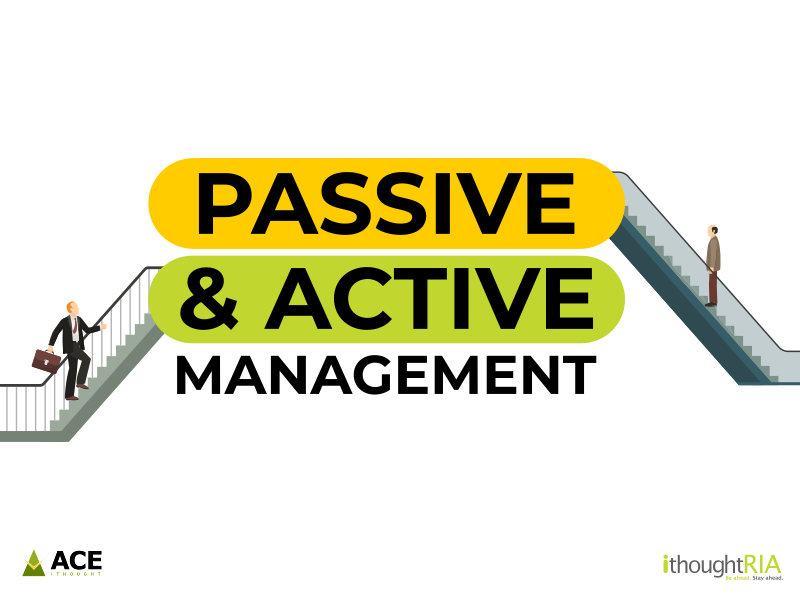
Today, an investor has multiple investment vehicles to ride on in their investment journey. A very broad but important choice comes in the method of management. Active or Passive? There are various advantages and drawbacks to both styles of investing. Active management has been prevalent and has dominated the markets for decades. Passively managed investments are relatively new but provide a wide range of options and are more cost-effective. In this blog, we take an in-depth look and see how they compare.
Active Management
Actively managed investments have a fund manager and a support team that take decisions on how to invest the capital. The funds have a benchmark (usually an index), and their aim is to outperform the benchmark on a consistent basis. Actively managed funds come with the comfort of the fund manager’s expertise and experience in the markets.
They are more expensive than their passive counterparts and hence require a higher level of outperformance to justify their higher costs. For example, if an actively managed fund returns 11% CAGR vs the underlying index which gives a 10% CAGR, and the fund has an expense of 1.5%, the fund’s net of expenses has returned only 9.5% and has therefore underperformed.
With active management, the fund manager is expected to outperform the benchmark and competing funds to meaningful extent post fees and other expenses. This style of management works better in sectoral/thematic investing and mid and small caps where there is more scope for outperformance via stock picking.
The benefits of active investment management are primarily the scope for higher returns. An index might also carry concentration risk where some stocks that have a higher weightage may be overvalued, and are forced into the index because of their market cap. Active management can eliminate these risks if the fund manager chooses to not participate in these stocks.
As we have seen, actively managed funds need to outperform their passive counterparts to even arrive at a comparable return. In addition to this, the most obvious risk is that an active fund manager might pick a stock that does not work out or follows a flawed investment strategy.
Passive Management
Passive Management is the opposite of active management. This method of investing attempts to follow an index or a specific rule-based strategy. Passive models are relatively new in the industry and are growing at a very fast pace. For example, a passively managed fund could be an equal-weighted index fund where the stocks selected are based on the index, but the weights are equally distributed. This manages concentration risk and can give a whole new dimension to the overall portfolio while reducing costs compared to an actively managed fund. Passively managed funds are not expected to beat their benchmarks. They are expected to follow their benchmarks closely with as little deviation as possible.
The most common form of passively managed investments is through an ETF. Exchange-Traded Funds are a basket of securities that are traded on the stock exchange. They can be bought and sold like how one would buy or sell a stock. Currently, there are 99 ETFs in India and the ETF space has grown from 15,000 crores in September 2015 to 2.18 Lakh Crores as on September 2020 which is an annual growth rate of 70%. There are hundreds of global ETFs available as well. ETFs can be created for any index, commodity, or passive strategies and therefore the opportunity for customization is endless. You can learn more about ETFs here.
Is Passive Management the Future?
There is no doubt on the potential of Passively Managed investments, but there are certain points in the economic cycle where a few high conviction bets can deliver outperformance. A competent fund manager would be able to achieve this. In sectoral and thematic investments, the expertise of a fund manager, a team of analysts and their ability to create a concentrated, high conviction portfolio will deliver superior performance. Careful selection is needed when going into illiquid spaces like small and micro caps.
The Role of an Advisor
With a plethora of options available, you need someone who knows what works and what doesn’t. An advisor is necessary, now more than ever. Even in passively managed assets, active advice is necessary. Knowing which assets to invest in at points in the cycle, can give you an advantage. An advisor also understands your requirements and goals and structures your investment portfolio to fulfil those goals.
ACE is a unique equity RIA with Mutual Funds, ETFs and select stocks. This has been backed by over a decade of equity research and experience in mutual fund advice. This product is the latest step in our ever-evolving advisory model. To know more get in touch with our advisors today!